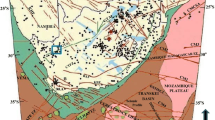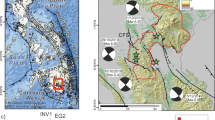Abstract
On 10 April 2014, an M w 6.1 earthquake struck central Nicaragua. The main event and the aftershocks were clearly recorded by the Nicaraguan national seismic network and other regional seismic stations. These crustal earthquakes were strongly felt in central Nicaragua but caused relatively little damage. This is in sharp contrast to the destructive effects of the 1972 earthquake in the capital city of Managua. The differences in damage stem from the fact that the 1972 earthquake occurred on a fault beneath the city; in contrast, the 2014 event lies offshore, under Lake Managua. The distribution of aftershocks of the 2014 event shows two clusters of seismic activity. In the northwestern part of Lake Managua, an alignment of aftershocks suggests a northwest to southeast striking fault, parallel to the volcanic arc. The source mechanism agrees with this right-lateral, strike-slip motion on a plane with the same orientation as the aftershock sequence. For an earthquake of this magnitude, seismic scaling relations between fault length and magnitude predict a sub-surface fault length of approximately 16 km. This length is in good agreement with the extent of the fault defined by the aftershock sequence. A second cluster of aftershocks beneath Apoyeque volcano occurred simultaneously, but spatially separated from the first. There is no clear alignment of the epicenters in this cluster. Nevertheless, the decay of the number of earthquakes beneath Apoyeque as a function of time shows the typical behavior of an aftershock sequence and not of a volcanic swarm. The northeast–southwest striking Tiscapa/Ciudad Jardín and Estadio faults that broke during the 1972 and 1931 Managua earthquakes are orthogonal to the fault where the 10 April earthquake occurred. These orthogonal faults in close geographic proximity show that Central Nicaragua is being deformed in a complex tectonic setting. The Nicaraguan forearc sliver, between the trench and the volcanic arc, moves to the northwest relative to the Caribbean plate at a rate of 14 mm/year. Part of the deformation is apparently accommodated by strain partitioning in the form of bookshelf faulting, on a system of orthogonal faults. The sinistral faults striking northeast–southwest rotate blocks of the Caribbean plate in a clockwise manner. The recent crustal earthquakes in central Nicaragua in 1931, 1972 and 2005 earthquakes took place on these left-lateral faults. The motion of the forearc sliver is also accommodated by a second set of right-lateral, strike-slip faults oriented parallel to the volcanic arc. Faults with this orientation and direction of motion are responsible for the 2014 and possibly the 1955 earthquakes. The presence of this geometry of orthogonal crustal faults highlights the seismic hazard posed by this complex faulting system, not only in the capital city of Managua, but also to the major Nicaraguan cities, which lie close to the volcanic arc.






Similar content being viewed by others
References
Algermissen, S. T., Dewey, J. W., Langer, C. J., and Dillinger, W. H. (1974). The Managua, Nicaragua, earthquake of December 23, 1972, Location, focal mechanism, and intensity distribution, Bull. Seismol. Soc. Am., 64(4), 993–1004.
Alvarado, D., C., DeMets, B. Tikokk, D. Hernández, T.F. Wawrzyeniec, C. Pullinger, G. Mattioli, H.L. Turner, M. Rodríguez, and F. Correa-Mora. (2011). Forearc motion and deformation between El Salvador and Nicaragua: GPS, seismic, structural and paleomagnetic observations, Lithosphere, 3, 3–21.
Ambraseys, N. N., and Adams, R. D. (1996). Large-magnitude Central American earthquakes, 1898–1994, Geophys. J. Int., 127(3), 665–692.
Avellán, D.R., Macías, J.L., Pardo, N., Scolamacchia, T., and Rodriguez, D. (2012). Stratigraphy, geomorphology, geochemistry and hazard implications of the Nejapa Volcanic Field, western Managua, Nicaragua, Journal of Volcanology and Geothermal Research, 213–214: 51–71.
Benoit, J. P., & McNutt, S. R. (1996). Global volcanic earthquake swarm database 1979–1989 (pp. 96–69). US Department of the Interior, US Gological Survey.
Bondár, I., Myers, S. C., Engdahl, E. R., & Bergman, E. A. (2004). Epicentre accuracy based on seismic network criteria. Geophysical Journal International, 156(3), 483–496.
Brown, R. D., Ward, P. L., and Plafker, G. (1974). Geologic and seismologic aspects of the Managua, Nicaragua, earthquakes of December 23, 1972, Bull. Seismol. Soc. Am., 64(4), 1031–1031.
Carr, M. J. (1976). Underthrusting and Quaternary faulting in northern Central America, Bull. Geol. Soc. Am., 87, 825–829.
Chatelain, J. L., Roecker, S. W., Hatzfeld, D., & Molnar, P. (1980). Microearthquake seismicity and fault plane solutions in the Hindu Kush region and their tectonic implications, Journal of Geophysical Research: Solid Earth (1978–2012), 85(B3), 1365–1387.
Cluff, L. S. and Carver, G. A. (1973). Geological observations, Managua, Nicaragua, earthquake of December 23, 1972, EERI Recon. Rept., Earthquake Eng. Res. Inst., Oakland, Calif, 5–20.
Correa-Mora, F., DeMets, C., Alvarado, D., Turner, H. L., Mattioli, G., Hernandez, D., and Tenorio, C. (2009). GPS-derived coupling estimates for the Central America subduction zone and volcanic arc faults: El Salvador, Honduras and Nicaragua, Geophys. J. Int., 179(3), 1279–1291.
Cowan, H., Prentice, C., Pantosti, D., de Martini, P., and Strauch, W. (2002). Late Holocene Earthquakes on the Aeropuerto Fault, Managua, Nicaragua, Bull. Seismol. Soc. Am., 92(5), 1694–1707.
DeMets, C. (2001). A new estimate for present‐day Cocos‐Caribbean plate motion: Implications for slip along the Central American volcanic arc, Geophys. Res. Lett., 28(21), 4043–4046.
DeMets, C., Mattioli, G., Jansma, P., Rogers, R. D., Tenorio, C., and Turner, H. L. (2007). Present motion and deformation of the Caribbean plate: Constraints from new GPS geodetic measurements from Honduras and Nicaragua, Special Papers, Geological Society of America, 428, 21.
Durham, H. W. (1931). Managua Earthquake of 1931, Engineering News Record, Apr. 22, 696–700.
Dziewonski, A.M., Chou T.A, and Woodhouse J.H (1981). Determination of earthquake source parameters from waveform data for studies of global and regional seismicity, J. Geophys. Res., 86, 2825–2852, doi:10.1029/JB086iB04p02825.
Fitch, T. J. (1972). Plate convergence, transcurrent faults, and internal deformation adjacent to southeast Asia and the western Pacific, J. Geophys. Res., 77(23), 4432–4460.
French, S. W., et al. Constraints on upper plate deformation in the Nicaraguan subduction zone from earthquake relocation and directivity analysis. Geochemistry, Geophysics, Geosystems 11.3 (2010).
Geist, E. L., J.R. Childs, and D.W. Scholl (1988). The origin of Summit basins of the Aleutian Ridge: Implications for block rotation of an arc massif, Tectonics, 7(2), 327–341, doi:10.1029/TC007i002p00327.
Gomberg, J. S., Shedlock, K. M., & Roecker, S. W. (1990). The effect of S-wave arrival times on the accuracy of hypocenter estimation, Bulletin of the Seismological Society of America, 80(6A), 1605–1628.
Jarrard, R. D. (1986). Terrane motion by strike-slip faulting of forearc slivers, Geology, 14(9), 780–783.
Kissling, E. (1988). Geotomography with local earthquake data, Reviews of Geophysics, 26(4), 659–698.
Kates, R. W., Haas, J. E., Amaral, D. J., Olson, R. A., Ramos, R., and Olson, R. (1973). Human impact of the Managua earthquake, Science, 182(4116), 981–990.
Kobayashi, D., LaFemina, P., Geirsson, H., Chichaco, E., Abrego, A. A., Mora, H., & Camacho, E. (2014). Kinematics of the western Caribbean: Collision of the Cocos Ridge and upper plate deformation. Geochemistry, Geophysics, Geosystems, 15(5), 1671–1683.
Knudson, C. F., Perez, V., and Matthiesen, R. B. (1974). Strong-motion instrumental records of the Managua earthquake of December 23, 1972, Bull. Seismol. Soc. Am., 64(4), 1049–1067.
Langer, C. J., Hopper, M. G., Algermissen, S. T., and Dewey, J. W. (1974). Aftershocks of the Managua, Nicaragua, earthquake of December 23, 1972, Bull. Seismol. Soc. Am., 64(4), 1005–1016.
La Femina, P. C., Dixon, T. H., and Strauch, W. (2002). Bookshelf faulting in Nicaragua. Geology, 30(8), 751–754.
La Femina, P.C., Dixon, T.H., Govers, R., Norabuena, E., Turner, H., Saballos, A., Mattioli, G., Protti, M., and Strauch, W. (2009). Forearc motion and Cocos Ridge collision in Central America, Geochem. Geophys. Geosys., v. 10, p. Q05S14, doi:10.1029/2008GC002181.
Leeds, D. J. (1974). Catalog of Nicaraguan earthquakes, Bull. Seismol. Soc. Am., 64(4), 1135–1158.
McBirney, A. R. and H. Williams (1965). Volcanic history of Nicaragua, Univ. Calif. Publ. Geol. Sci., 55, 1–65.
McCaffrey, R. (1992). Oblique plate convergence, slip vectors, and forearc deformation, J. Geophys. Res., 97(B6), 8905–8915.
Mogi, K. (1963). Some discussions on aftershocks, foreshocks and earthquake swarms: the fracture of a semi-infinite body caused by an inner stress origin and its relation to the earthquake phenomena, 3, Bull. Earthquake Res. Inst., Tokyo Univ. 41. 615–658.
Omori, F. (1894). On the aftershocks of earthquakes. Journal of the College of Science, Imperial University of Tokyo 7: 111–200.
Pardo, N., Macías, J.L., Giordano, G., Cianfarra, P., Avellán, D.R., and Bellatreccia, F. (2009). The ~1245 yr BP Asososca maar eruption: The youngest event along the Nejapa-Miraflores volcanic fault, Western Managua, Nicaragua, Journal of Volcanology and Geothermal Research, 184: 292–312.
Rojas, W., Bungum, H. and Lindholm, C. (1993). Historical and recent earthquakes in Central America, Revista Geológica de América Central, 16.
Stirling, M. W., Rhoades, D., and Berryman, K. R. (2002). Comparison of scaling relations derived from data of the instrumental and preinstrumental eras, Bull. Seismol. Soc. Am., 92, 355–375.
Stoiber, R. and Carr, M. (1973). Quaternary volcanic and tectonic segmentation of Central America, Bulletin Volcanologique, 37(3), 304–325.
Sultan, D.I. (1931). The Managua earthquake of 1931, Military Engineer, 92, 354–361.
Turner, H. L., III, P. LaFemina, A., Saballos, G. S. Mattioli, P. E. Jansma, and T. Dixon (2007). Kinematics of the Nicaraguan forearc from GPS geodesy, Geophys. Res. Lett., 34, L02302, doi:10.1029/2006GL027586.
Utsu, T. (1961). A statistical study of the occurrence of aftershocks. Geophysical Magazine 30: 521–605.
Utsu, T.; Ogata, Y.; Matsu’ura, R.S. (1995). The centenary of the Omori formula for a decay law of aftershock activity, Journal of Physics of the Earth 43: 1–33.
White, R. A. (1991). Tectonic implications of upper-crustal seismicity in Central America, in Neotectonics of North America: Slemmons, D. B., Engdahl, E. R., Zoback, M. D., and Blackwell, D. (Editors), Boulder, Colorado, Geological Society of America, pp. 323–338.
White, R. A. and Harlow, D. H. (1993). Destructive upper-crustal earthquakes of Central America since 1900, Bull. Seismol. Soc. Am., 83(4), 1115–1142.
Ward, P. L., Gibbs, J., Harlow, D., and Aburto, A. (1974). Aftershocks of the Managua, Nicaragua, earthquake and the tectonic significance of the Tiscapa fault, Bull. Seismol. Soc. Am., 64(4), 1017–1029.
Weinberg, R. F. (1992). Neotectonic development of western Nicaragua, Tectonics, 11(5), 1010–1017.
Wells, D. L. and Coppersmith, K. J. (1994). New empirical relationships among magnitude, rupture length, rupture width, rupture area, and surface displacement, Bull. Seismol. Soc. Am., 84(4), 974–1002.
Wesnousky, S.G. (2008). Displacement and geometrical characteristics of earthquake surface ruptures: Issues and implications for seismic-hazard analysis and the process of earthquake rupture, Bull. Seismol. Soc. Am., 98(4), 1609–1632.
Wright, R.N and Kramer, S. (1973). Building performance in the 1972 Earthquake, National Bureau of Standards Technical Note 807, Washington D.C., 155 pp.
Wyllie, L. A., Wright, R. N., Sozen, M. A., Degenkolb, H. J., Steinbrugge, K. V., and Kramer, S. (1974). Effects on structures of the Managua earthquake of December 23, 1972, Bull. Seismol. Soc. Am., 64(4), 1069–1133.
Acknowledgments
The authors acknowledge Grant Number 082821 from the Mexican Council of Science and Technology (CONACYT) for support in conducting this work and a grant from the Secretaría de Relaciones Exteriores de México (Foreign Ministry of Mexico), which allowed the authors to enjoy scientific exchange visits. Thanks are due to the Instituto Nacional de Estudios Territoriales of Nicaragua (INETER) for providing data from the national seismic network. Support from Jorge A. Castillo in relocating the mainshock of 10 April is acknowledged. The authors would like to thank two anonymous reviewers and W. Bandy for valuable comments and suggestions that greatly improved the paper.
Author information
Authors and Affiliations
Corresponding author
Rights and permissions
About this article
Cite this article
Suárez, G., Muñoz, A., Farraz, I.A. et al. The 10 April 2014 Nicaraguan Crustal Earthquake: Evidence of Complex Deformation of the Central American Volcanic Arc. Pure Appl. Geophys. 173, 3305–3315 (2016). https://doi.org/10.1007/s00024-015-1201-z
Received:
Revised:
Accepted:
Published:
Issue Date:
DOI: https://doi.org/10.1007/s00024-015-1201-z




